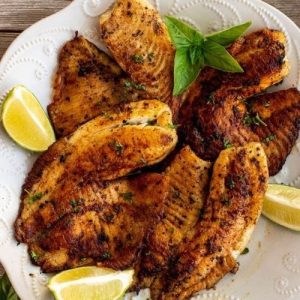
Pan Seared Tilapia
This pan-seared tilapia is light, flaky, and packed with flavor from garlic, paprika, and basil. Ready in just 25 minutes, it’s a wholesome, protein-rich dinner that pairs beautifully with fresh sides, salsas, or even tacos. A quick, satisfying dish perfect for weeknight cooking.
Equipment
- 1 Large plate
- 1 Skillet (preferably cast iron, 10–12 inch)
- 1 Measuring spoon set (for spices)
- 1 Cooking spatula or fish turner
- 1 Small mixing bowl (optional, for spices)
Ingredients
- 1 pound about 4 tilapia fillets
- ½ teaspoon salt
- ⅛ teaspoon ground black pepper
- ½ teaspoon garlic powder
- ½ teaspoon paprika
- ½ teaspoon dried basil
- 2 tablespoons olive oil divided
Instructions
- Prepare and Pat Dry the Fillets: Start by removing your tilapia fillets from the packaging and placing them on a large plate or tray. Use paper towels to gently pat each fillet dry on both sides. This step is very important because excess moisture on the surface of the fish can prevent a nice sear and cause the fillets to steam instead of crisp up. Drying ensures the seasonings will stick well and helps create a golden-brown crust when cooked.
- Season Generously with Spices: In a small bowl, combine the salt, ground black pepper, garlic powder, paprika, and dried basil. Drizzle one tablespoon of olive oil over the fish, then sprinkle the seasoning blend evenly over both sides of each fillet. Use your hands to gently rub the mixture into the fish, ensuring every surface is coated with flavor. Tilapia is a mild fish, so this seasoning not only adds depth but also balances the natural sweetness of the fish.
- Preheat the Skillet for Perfect Sear: Place a heavy-bottomed skillet—preferably a cast iron pan—on the stove over high heat. Add one tablespoon of olive oil and allow it to heat for about 3 minutes, until the oil shimmers and lightly ripples. A properly heated pan is crucial for creating a crisp, golden sear without sticking. If you’re unsure whether the pan is hot enough, carefully flick a drop of water into it; it should sizzle immediately and evaporate.
- Cook the First Batch of Fillets: Once the pan is hot, reduce the heat to medium and carefully place two fillets into the skillet, laying them away from you to avoid splattering oil. Let the fillets cook undisturbed for about 4 minutes. Do not move or flip them during this time—this allows the bottom to develop a flavorful crust. You’ll notice the edges starting to turn opaque as the fish cooks through.
- Flip and Finish Cooking: Using a spatula or fish turner, gently slide under each fillet and flip them over. Cook the second side for an additional 3–4 minutes, depending on the thickness of your fillets. The fish is ready when it flakes easily with a fork and turns opaque all the way through. Avoid overcooking, as tilapia can become dry if left too long in the pan.
- Repeat with Remaining Fillets: Remove the cooked fillets from the skillet and transfer them to a clean plate. Add the remaining tablespoon of olive oil to the pan, allow it to heat for a minute, and repeat the cooking process with the remaining two fillets. This ensures the fish cooks evenly without crowding the pan, which could cause steaming instead of searing.
- Serve and Add Fresh Finishing Touches: Once all the fillets are cooked, serve them immediately while still warm. For extra brightness, pair the fish with fresh lime or lemon wedges on the side. A quick squeeze of citrus right before eating enhances the flavor and cuts through the richness of the oil. For a colorful, refreshing contrast, try serving with mango avocado salsa, a fresh salad, or tucked into warm tortillas for fish tacos.
Notes
- Always use completely thawed tilapia fillets for best results. Defrost them in the refrigerator for at least 24 hours, or for a quicker method, seal them in a Ziploc bag and submerge in cold water until thawed.
- Patting the fillets dry before seasoning is crucial—it prevents steaming and helps create a golden, crispy exterior.
- Adjust cooking times depending on fillet thickness; thinner fillets may need slightly less time, while thicker ones may need a little longer to cook through.
- This recipe is naturally low in carbs and rich in lean protein, making it ideal for a balanced, health-conscious meal.